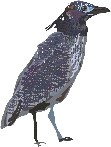




| There are many bird watching spots in the Taipei Metropolitan Area. We will choose three of the largest bird spots in Taipei to actually walk through and introduce them: | ||||||||||||
| Daan Forest Park | ||||||||||||
Daan Forest Park is a specially built ecological pool
facility and set with a bird watching platform. The Wild Bird Society
of Taipei set up a commentary station here, which can guide the
visitors’ tour by comparing with the explanatory diagrams, the visitors
can observe from a telescope to enjoy bird ecology. Here is also the
filming location of “Spotted-necked dove in my house”, and readers of
interests can click on the link. The guide lead us start from the park walkway, and suddenly everyone stopped. It turned out that there was a Formosan blue magpie on the distant building, and it looked very beautiful from the telescope. We were really curious how the guide found the bird from so far away, the guide told us that the lines of the building itself were very regular. If we see irregularities, black spots, or moving shadows from the distance, we can pick up the telescope. This is how we observe this Formosan blue magpie. Later, after several bird watching, we learned that the bird that everyone sees for the first time could be called the bird of life. This bird may be the key bird that takes us into the world of flying feathers. Then we saw Taiwan barbet, turtle doves, light-vented bulbul, and black-crowned night heron. We were all amazed. We also saw the Tiger bittern eating earthworms, and everyone took photographic equipment to snap this scene, everyone was exclaimed especially at the moment when the Tiger bittern pulling the earthworm. At present, there were more than 10 species of birds nesting in the park, including little egret, common moorhen, white-breasted waterhen, black bulbul, night heron, Tiger bittern, warbling white-eyes, Asian koel, Taiwan barbet, yellow-necked black egret, European blackbird, Japanese waxwing, etc. | ||||||||||||
| ||||||||||||
The best bird watching season is from March to June. The
birds cannot stand the heat, so the bird watching time in summer is
from 6:00 to 8:00 am, from 3:30 to 5:00 pm, and from 7:00 to 12:00 am
and 2:00 to 4:00 am in spring, autumn and winter. After explained by
Mr. Shi-Yao Chen, we realized that we shall get up early for bird
watching, because early birds get worms to eat! We stopped at the
ecological pool and began to count the bird species we saw today, Mr.
Shi-Yao Chen held a record sheet. Mr. Shi-Yao Chen told us that bird
records can help us to know the traces and quantity of birds, and it
was helpful for us to monitor environmental changes. Every routine
activity will have records. Grey-spotted cormorants, gray starlings,
and 25 bird species are recorded today. These records will be uploaded
to e-bird, which will be stored in this database, which can be
scientifically analyzed to provide important reference for conservation
work in the future. | ||||||||||||
























